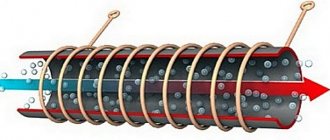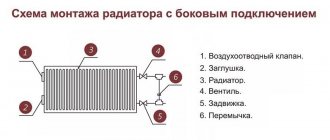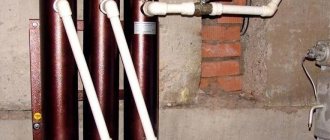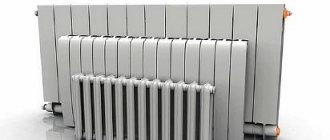However, by and large, this is an advertising trick by marketers, which the majority believed in and, as a result, did not receive any savings.
In reality, these units have obvious disadvantages even at first glance:
- very high price
- large dimensions
- Difficulty in operation when connecting additional equipment (boiler)
Manufacturers loudly advertise their positive qualities, but if you look at them in more detail, even they seem very dubious.
How do advertisers communicate these benefits? They almost always compare it with a heating element boiler. Since they occupy 90% of the electric boiler market.
At the same time, the disadvantages (real or imaginary) for equipment with heating elements are highlighted, and the advantages are given, which are not even close to this in induction ones. Which means they are better.
Let's go over these disadvantages and advantages in more detail.
No heating element
First, the electric boiler is induction, supposedly there are no heating elements. But in a heating element, sometimes there are more than a dozen of them, which means there is a high probability of them breaking, maybe several at once.
But if there were no heating element, then how would the boiler heat the water? The same coil essentially performs this role, only without contact with the liquid. Therefore, this element is present in any such unit.
But as for the high probability of heating elements failing, this directly depends on the product and manufacturer that you buy.
There are specialists who have installed more than 500 heating element boilers over the years of their work, and have not changed a single element under warranty during all this time.
Summarizing
Electrode installations have increased reliability and safety in the event of a liquid supply interruption, but the equipment requires the preparation of a special solution. When the device operates, stray currents arise that destroy metal parts of the structure.
Equipment production is carried out by small companies, while electrode boilers do not provide energy savings. Therefore, it is recommended to use standard heating devices with heating elements produced by large companies in homes.
Connections and flanges
The second drawback in comparison is the large number of sealing connections (heating elements, flanges) and their complete absence in an induction boiler. Here these advantages and disadvantages can even be swapped.
After all, if the heating element does fail, you can easily replace it. Or simply exclude it from the circuit for a short time, set the jumpers differently and continue working.
But if the coil burns out (due to an interturn short circuit), how much will the repair cost you? And will you be able to keep warm with such a breakdown?
Operation of electric boilers: fourth year
There are no significant changes in the economy of our enterprise. We are already accustomed to the fact that during the season we need to regularly monitor the operation of the heating element boiler. They even installed a GSM control system on it. But we will not take these costs into account: after all, we agreed that we are evaluating a “clean pot” without piping.
Thermal productivity continues to decline, by 20%. It is due to the fact that the old heating elements are working. Their reliability is deceptive: they work, but they don’t provide power. As they say, it’s a pity to throw it away, but it’s more expensive to keep it.
By the end of the 4th year of operation, almost all heating elements that were once new had to be replaced. Still, some of them honestly worked 10 thousand hours – an excellent indicator.
With an induction heater you can only wipe off dust - absolutely nothing else.
| Fourth year | Induction heater | New heating element |
| Heating period, days. | 200 | 200 |
| Continuous operation time, hour/day. | 10 | 15,18 |
| Energy tariff | 2,8 | 2,8 |
| Electricity costs, rub/season | 50×200×10×2,8=280 000 | 50×200×15,18×2,8=425 040 |
| Risk of accident | 0 | 50 |
| Costs of consumables, rub. | 0 | 10,000 (replacement of 5 heating elements) |
| Labor costs for operation* | 0 | 950 |
| Current expenses for the period | 280 000 | 425 040+10 000+950=435 990 |
| Total expenses on a cumulative basis | 985 000+280 000=1 265 000 | 994 960+435 990=1 430 950 |
By the end of the fourth year of operation, the induction heater is already an absolutely confident leader in our competition, actually saving the enterprise money, not only monetary, but also time and human.
Only one thing can be said about the tensile boiler: if this continues, the electrician will only deal with it and will have to hire another one to work with the rest of the equipment...
Water softening and scale
The third point is that with poor water preparation and heavy load, scale forms on the surface of the heating elements. In induction, scale is excluded.
Firstly, the same scale that many people imagine based on the example of a kettle does not exist in heating systems. Because the liquid does not boil there.
But deposits, of course, are always and everywhere. Moreover, in any systems - gas, heating elements, wood, induction, etc.
"scale" in a gas boiler
These are exactly the impurities that are present in water anyway. Pour water into a clean glass, let it evaporate and you will see a thin film on the walls.
Therefore, the presence of an impurity or its absence is not a disadvantage or an advantage, but a given of any heating system.
Which is easier to use
Operation of a standard boiler does not require the preparation of liquid or the installation of protective equipment against electric shock. To turn on the equipment, you must press the button or move the lever of the package switch.
The installation will automatically heat the liquid to a predetermined temperature; the boiler design provides a separate circuit for preparing hot water, which is supplied through mixers to the bath or sink.
When using electrode installations, a reduction in the electrical conductivity of antifreeze is required. As electricity passes through the working fluid, the risk of electric shock increases. Protection using RCD devices is impossible, since the device will constantly operate, recording the leakage current.
When starting a cold installation, the supplied power may not be enough to start heating the room. To compensate for the deficiency, it is necessary to increase the temperature of the liquid (for example, using a tubular heater) or increase the electrical conductivity.
An increase in conductivity at low temperatures leads to an excessive increase in the parameter after heating the solution. As a result, the load on the power circuits and the electronic control unit increases. An additional problem is the possibility of breakdown of the gap between the electrodes filled with liquid.
As a result of a short circuit, a current surge occurs in the network, which disables the connected equipment. To organize hot water supply, it is necessary to install a second circuit, isolated from live parts.
Loosening contacts
Terminal contacts in heating element models, most of them, can be in temperature difference mode. Heating at maximum load, and cooling when switched off.
And this imposes obligations for their revision and tightening.
And in induction, there are supposedly no electrical contacts. In fact, they are always and everywhere, including induction ones.
But as for the former, in recent years specimens with high-quality screw clamps have begun to be produced.
Or there may be screw connections with a locking washer, which do not require maintenance, or spring clamps, which also go without control and revision for years.
In fact, these are just made-up benefits.
Experts advise
Purchasing heating equipment is a rather complicated issue. It must meet many parameters, but which ones should you pay attention to first? Experts recommend first calculating the boiler power.
Moreover, for electric models, the network to which it will be connected depends on it. Most models with a power rating of up to 12 kW are single-phase, and those exceeding this threshold are three-phase. Typically, the boiler power is calculated using the formula, or in the case of good insulation of the building, it is taken at the rate of 1 kW per 1 m².
The next parameter is the efficiency of the device. It depends on its type, as well as on the presence of several stages of power adjustment. This parameter makes it possible to rationally use energy, especially in autumn or spring.
It is necessary to pay attention to the equipment, it can be different. There are electrode-electric boilers equipped with an expansion tank and a circulation pump, as well as a safety group, that is, they are a mini-boiler room. But there are also the simplest samples that do not have any additional equipment, which are best used only as backup sources of heating the coolant.
Only taking into account all the considered parameters can you choose the most optimal boiler option, which will consume energy economically and maintain a comfortable temperature in the room.
Replacing the heating element
The service life of heating elements depends on the quality of the coolant. As “comparators” assure, this is only 1000 hours of work, if you do not take action and soften hard water. Well, if they softened it, then about 5000.
When using this data, the heating and water supply systems are confused.
In closed heating systems there are not as many impurities as in water supply. In most cases, water softening is simply not required here.
This may only apply to domestic hot water or central heating. There, the boiler room operator is unable to track water leaks.
If we are talking purely about your home, where everything is assembled and connected without leaks or holes, then no constant water preparation is required. Of course, the water will contain some elements, but once they are poured into the heating system, they will react once or more; they will have nowhere to come from.
Induction ones supposedly have low operating costs due to the very rare replacement of components. In fact, this is in high-quality PETN samples; the elements change extremely rarely, as mentioned above.
But if you need to change something in the induction room, you will think twice before doing it. Everything there is sealed in a sealed flask and you can’t get inside without physically cutting it.
Payment terms
To ensure that our comparison is objective and impersonal, we will not use specific brands of equipment or specific objects in our analysis. Moreover, since the price range is extremely wide, there is no point in choosing a specific brand of product. We use average figures, which, however, are subject to comparison: prices, power and completeness of conventional products are quite comparable. 50 kW is the power of the induction heater and 50 kW of the heater (and in the latter, we will assume there are only 10 heating elements of 5 kW each).
We will compare at current average prices, without taking into account inflation and regional reference, since if you enter this data, the calculations will become much more complicated: each region has its own tariff setting, and the official inflation rate has little connection with the level of annual growth in electricity tariffs, so we will omit these factors .
We are not particularly interested in the characteristics of the heated object: if heating a room requires 50 kW of energy (or 43,000 kcal), then it does not matter which heater we choose - a heating element or an induction one - to maintain the desired temperature, they must produce the same amount of heat. We can only say that a 50 kW boiler can approximately heat a facility with a total area of about 600 m2 with a ceiling height of 3 m (responsible boiler suppliers will never recommend their equipment without assessing the facility where the equipment will operate and will always offer to make a calculation based on specific characteristics object).
Decrease in electric boiler efficiency
Another argument for comparison is that an induction boiler does not lose its original power during operation. But with heating element, due to scale formation, this happens as a matter of course.
Even sometimes calculations are given, according to which, within just one year, the power of a heating element decreases by 15-20%. This means that its efficiency also decreases.
Let's look at this in more detail.
Almost any electric boiler has an efficiency exceeding 98%. And even boilers operating at ultra-high frequency currents from 25 kHz and above, what can they change for you? Add an extra one and a half percent, but at the same time jump the price by 100%?!
As for deposits on the heating element element, they are indeed present.
In water supply systems in direct heating boilers, a certain “scale” is deposited on the working element. It actually gradually prevents the water from heating up quickly.
What happens where there is no constant supply of impurities? A small layer of deposits may settle on the heating element, however:
- this layer is not thick enough
- it does not in any way interfere with heat transfer
For example, let’s assume that on a clean surface of the heating element, heat transfer occurs at t=60 degrees. As soon as this surface becomes contaminated with deposits, heat exchange will not disappear anywhere, but will begin to occur at high degrees, say 75-80C.
And accordingly, the boiler in no way loses its original efficiency.
That is, in fact, both on a clean heating element and on a dirty one, the same amount of energy is transferred, only at different temperatures.
Manufacturers of electric heating equipment
The domestic market offers products from various manufacturers. Not only foreign but also Russian companies lead the list.
Among the most popular are boilers from companies:
- Dacon (Czech Republic) its model range consists of 30 modifications of devices with power from 4 to 60 kW, while boilers up to 12 kW can be connected to a single- and three-phase network. Some of the samples, for example PTE L, have quiet running contactors, a circulation pump, a safety valve and an expansion tank.
- Kospel (Poland) - the company's products are single-circuit devices, as well as electric electrode boilers with multi-stage power phases in the range from 4 to 36 kW. They differ in the method of adjustment: manual and software. Basic models include: EKCO R, EKCO L 1, EKCO L.
- RusNIT (Russia) - represented by N and Country samples, they have a power range from 3 to 55 kW and are adapted to work under conditions of power surges in the network.
conclusions
In the worst case, when everything is not in favor of an induction electric heater, its purchase will still become more profitable after three years of operation. In practice, this deadline may come much earlier. And the higher the enterprise’s need for electric heating, and the more powerful the installations, the more profitable the purchase of induction electric boilers will be, because we based our calculations on a comparison of 50 kilowatt equipment and it’s not difficult to imagine how big the difference will be for, say, 500 -kilowatt electric boiler.
PS or answer to those who like to calculate NPV
There are specialists (usually with an economic education) who could say: “All this is nonsense! The author cites figures that are far from the real economy - he cites bare numbers, but in reality it is necessary to consider at least NPV (net present value), and then the whole picture may not be so rosy at all!”
Such arguments look ironclad. But only until we take and calculate this terrible NPV. Simply put, we can calculate how much we would earn if we had an amount of 145,000 rubles. and we could have bought an induction electric boiler, but we decided to save money and bought a shadow one for 40,000. And the saved money (105,000 rubles) would have been deposited in the bank at interest, and we would have even made money on it. Every year we would gain about 10% (in fact, most likely even less). By the end of the 5th year, we could withdraw 169,100 rubles from the bank. Those. would have received an additional 60 thousand in profit. There would be no limit to the joy until we returned to the calculations for our heaters. During the same time, we lost 321,940 rubles. - more than 5 times more than they earned. As they say, the miser pays twice. And then he pays extra.
Boilers for houses up to 60 sq. m.
1
Teplodom i-TRM SILVER StS 6 6 kW single-circuit
Rating:5.0
- Thermal power: 6 kW
- Mains voltage: single-phase/three-phase
- Power levels: 3
- Heated area: 60 sq.m
- Coolant temperature: 5 – 80 °C
- Functions: auto-diagnostics, frost protection, pump blocking protection
Average price: RUB 20,300
The electric boiler with microprocessor control has an intuitive user interface and provides adjustment of the coolant temperature within the range of +5℃ ... +80℃. The smart system ensures alternating operation of the heating elements in order to ensure their uniform depreciation. Seven-voltage switches open and close the network silently, so there will be no clicks characteristic of relay ECUs.
When connecting an external water meter with a pulse output, the boiler will turn off without operator intervention if the flow in the heating circuit stops for some reason.
Peculiarities:
- durable heating element made of stainless steel;
- the ability to participate in a cascade connection paired with other boilers;
- presence of an input for an external thermostat and weather-compensating automation;
- maintaining operability at extreme voltage values.
With a 3-phase connection, the boiler has another advantage - it automatically selects the priority phase to even out the load on the electrical network.
2
EVAN EPO 6 6 kW single-circuit
Rating:4.9
- Thermal power: 6 kW
- Mains voltage: single phase
- Efficiency: 99%
- Heated area: 60 sq.m
- Coolant temperature: 30 – 85 °C
- Functions: power-on indication, overheat protection
Average price: RUB 12,550
An inexpensive electric heating boiler can be integrated into a heating system with natural circulation or a built-in pump. Tap water or antifreeze can be used as a coolant. The temperature in the range of +30℃…+85℃ is smoothly regulated using a built-in thermostat.
Peculiarities:
- electric heater made of high-quality stainless steel;
- emergency thermal switch that turns off the boiler when the coolant temperature reaches 92;
- possibility of connecting an external thermostat;
Unlike the previous model, EVAN EPO 6 does not have such rich functionality, but the price of the unit is much lower.
3
Teplodom iTRM-6 SILVER 6 kW single-circuit
Rating:4.8
- Thermal power: 6 kW
- Mains voltage: single-phase/three-phase
- Heated area: 60 sq.m
- Maximum current 3F: 16 A
- Coolant temperature: 30 – 80 °C
- Functions: autodiagnostics, frost protection, power-on indication, overheating protection, thermometer
Average price: RUB 13,900
The Teplodom electric boiler is equipped with a rich set of useful functions, and has a huge price advantage among similar models. The triac electronics used in this unit operate silently and are resistant to surge voltage surges. Steel heating elements have a special chemical coating that extends their service life. The frost protection system, emergency shutdown and self-diagnosis allow the device to remain operational for a long time.
Peculiarities:
- presence of an input for weather-compensating automation;
- advanced digital, LED and sound indication;
- intelligent power modulation with phase selection.
This electric boiler is suitable for a private home or cottage as a main or backup heat source. The boiler can be connected to 220 V or 380 V electrical networks.










